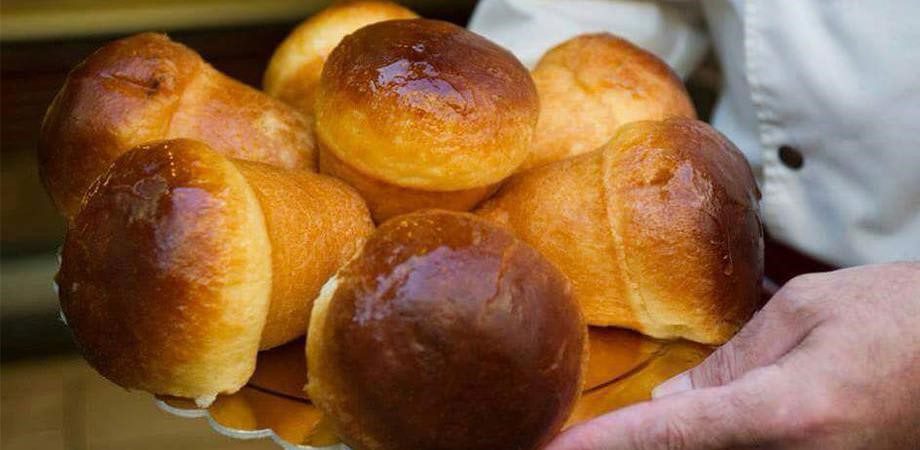HISTORY OF BABA’ AU RUM
A triple gastronomic alliance between Poland, France, and Naples, developed a masterpiece in the aristocratic indulgence of sumptuous patisserie in the high courts of Europe in the 18th Century.
Flavors and Knowledge
FOTO: {Image attribution via Capparelli Pastry Shop Via dei Tribunali, 325 – 80138 Naples}
Tour Italy 2022
Buongiorno amici:
Among gourmands, the wheat and ricotta pastiera represent the Latin soul of Campania, while Sfogliatella evokes its contacts with the Arab world and the humble monasteries. The Babà, however, symbolizes the richness of the Bourbons Neapolitan ruling courts in the Europe of the 18th Century.
It is a dessert for all seasons, disconnected from religious holidays such as Christmas and Easter and ritual occasions such as baptisms and weddings. Every moment is the right one to savor a baba in a single-portion version in the traditional Bouchon shape, reminiscent of the cork of a bottle of champagne tight underneath and domed above, or sliced when the baba is giant and with the typical donut shape with the hole in the center. Yet what all consider today to be a typical Neapolitan and Campania, a totem food that more than others has become a gastronomic symbol of the dolce vita in Vesuvius’s shadow, was not born here.
It was invented in the early eighteenth century by a Polish king, Stanislao Leszczyllski. He lived part of his life in exile in the French city of Luneville, where his pastry chef Nicolas Stohrer tried to alleviate his political pains by continually churning out new creations. As a result, the chef achieved stardom status in the European patisserie and confectionery.

[Image attribution via Pasticceria Capriccio Via Carbonara, 39 – 80139 Naples}
Subscribe now
According to legend, one day, the Polish king had the idea of dunking a kugelopf, the traditional bundt-shape Central European dessert, in Madeira, a fortified wine produced in Malaga. Soaked in the sweetened liquid and scented with raisins, the delight conquered the king’s palate, who decided to baptize the new dessert with the name of Ali Babà, his favorite character in the tales of the Thousand and One Nights.
The version of events reported by Stohrer’s heirs is instead different. Their ancestor would have invented the dessert who dipped brioche dough in Malaga wine and then filled it with saffron flavored custard, raisins, and fresh grapes macerated in the exact wine. But, instead, the king would have come up with the idea, also successful, of calling it Ali Babà.
Sometime later, the baba and Stohrer arrived at Versailles’s palace following Leszczyrlski’s daughter, Maria, who married Louis XV of France in 1725. The brilliant Polish pastry chef received the license to open a patisserie in the center of Paris, more precisely at 52 Rue Montorgueil, where the prestigious sign still stands out today as it did then. The original baba has many variations, such as chantilly cream, fresh fruit garnished with cherries, or dried apricots soaked in rum. The glorious baba au rum is strictly a Neapolitan invention, but perhaps a French version’s feathery remake.

{Image attribution via Mazz Bar Via Dei Tribunali 359 – 80138 Naples}
Give a gift subscription
The dough goes through a triple leavening process, soaked in rum diluted with a syrup of water and sugar and for the external apricot jam lacquering. The coating waterproofs the outside of the cake and allows it to remain moist and soft inside for days. In Naples, the babà becomes airy, passing from the severe original richness to the delicious lightness, typical of the Neapolitan temperament.
Anthelme Brillat-Savarin (Author of Taste’s Physiology) implemented corrective measures to the sweets and developed a new version of Stohrer’s workhorse creation in the nineteenth century, removing the dough’s raisins and adding fresh butter. Also, he devised the new donut-shaped, filling the center with cream and fruit in syrup.
In Campania pastry shops, this version is still prevalent and is called babu savarin. It has yellow cream and black cherries, even if combined with cream and wild strawberries for some years. If the baba is born in Paris, it is inevitably reborn in Naples. The rebirth is decisive for a dessert history that owes its fame above all to the Neapolitan version.
The so-called monsù, the French cooks who worked in the Neapolitan aristocratic palaces, were most likely decisive, creators of an extraordinary mix between Neapolitan tradition and French cuisine vividly recognized in exceptional dishes such as potato gattò and pasta au gratin.
In short, the babà is the result of a triple gastronomic alliance between Poland, France, and Naples, which has given this dessert its strong Mediterranean imprint, remaking it in its image and likeness. The result is a masterpiece of the highest patisserie blending haute cuisine and street flavors and lightness—the aristocracy’s conquest.
Share Flavors + Knowledge
Thanks for reading. Eat safe! Ciao Chef W
Download Chef Walters E-Books
Would you mind tuning in to our latest Flavors + Knowledge Podcast
Subscribe to the Italian version SAPERE + SAPORI
Subscribe to News you can eat 24 Video-Cast on YouTube
Support Chef Walters Children’s Diabetes Foundation
For recipes, visit the chef blog.
Corporate Website
© 2021 Chef Walters Cooking School Unsubscribe













